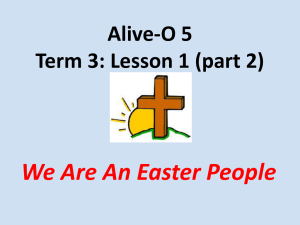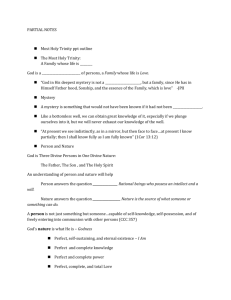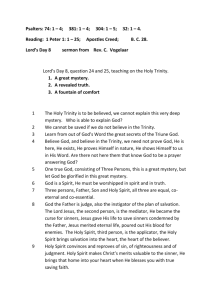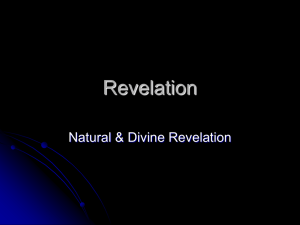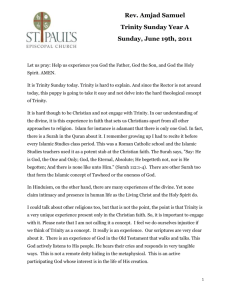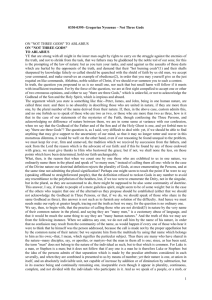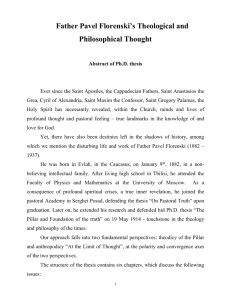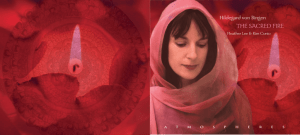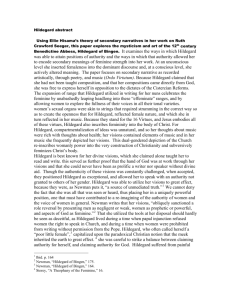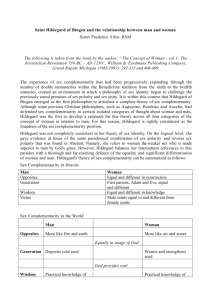ctime.370_Trinity_in_visions_of_Hildegard
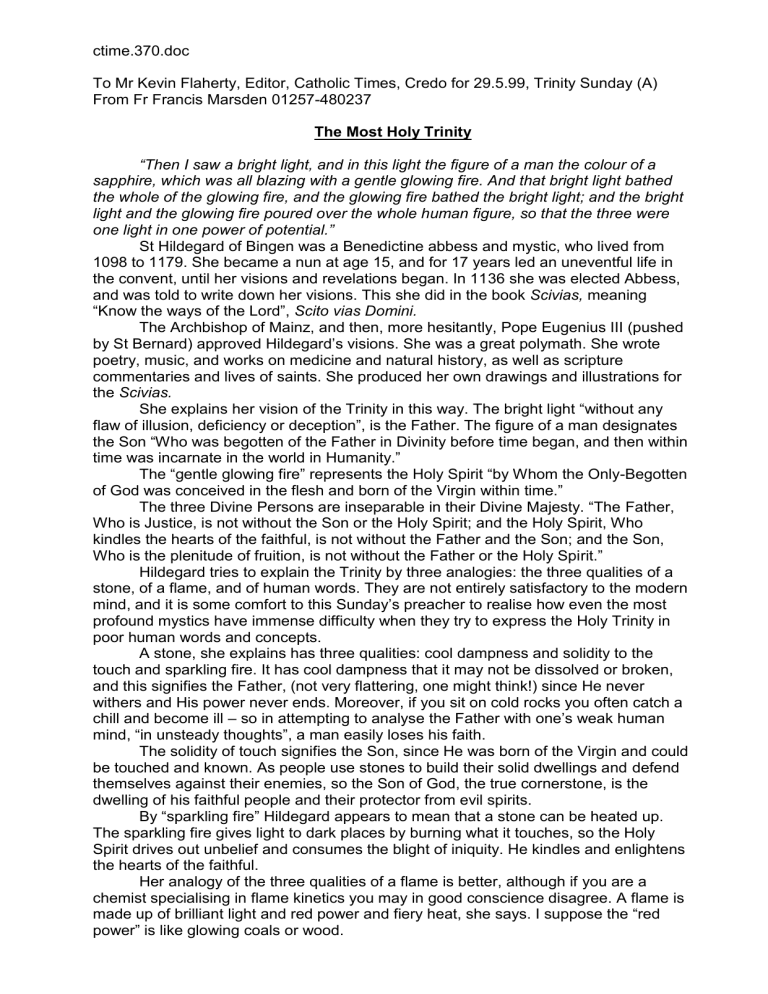
ctime.370.doc
To Mr Kevin Flaherty, Editor, Catholic Times, Credo for 29.5.99, Trinity Sunday (A)
From Fr Francis Marsden 01257-480237
The Most Holy Trinity
“Then I saw a bright light, and in this light the figure of a man the colour of a sapphire, which was all blazing with a gentle glowing fire. And that bright light bathed the whole of the glowing fire, and the glowing fire bathed the bright light; and the bright light and the glowing fire poured over the whole human figure, so that the three were on e light in one power of potential.”
St Hildegard of Bingen was a Benedictine abbess and mystic, who lived from
1098 to 1179. She became a nun at age 15, and for 17 years led an uneventful life in the convent, until her visions and revelations began. In 1136 she was elected Abbess, and was told to write down her visions. This she did in the book Scivias, meaning
“Know the ways of the Lord”,
Scito vias Domini.
The Archbishop of Mainz, and then, more hesitantly, Pope Eugenius III (pushed by St Bernard) appro ved Hildegard’s visions. She was a great polymath. She wrote poetry, music, and works on medicine and natural history, as well as scripture commentaries and lives of saints. She produced her own drawings and illustrations for the Scivias.
She explains her vision of the Trinity in this way. The bright light “without any flaw of illusion, deficiency or deception”, is the Father. The figure of a man designates the Son “Who was begotten of the Father in Divinity before time began, and then within time was inca rnate in the world in Humanity.”
The “gentle glowing fire” represents the Holy Spirit “by Whom the Only-Begotten of God was conceived in the flesh and born of the Virgin within time.”
The three Divine Persons are inseparable in their Divine Majesty. “The Father,
Who is Justice, is not without the Son or the Holy Spirit; and the Holy Spirit, Who kindles the hearts of the faithful, is not without the Father and the Son; and the Son,
Who is the plenitude of fruition, is not without the Father or the Holy Spi rit.”
Hildegard tries to explain the Trinity by three analogies: the three qualities of a stone, of a flame, and of human words. They are not entirely satisfactory to the modern mind, and it is some comfort to this Sunday’s preacher to realise how even the most profound mystics have immense difficulty when they try to express the Holy Trinity in poor human words and concepts.
A stone, she explains has three qualities: cool dampness and solidity to the touch and sparkling fire. It has cool dampness that it may not be dissolved or broken, and this signifies the Father, (not very flattering, one might think!) since He never withers and His power never ends. Moreover, if you sit on cold rocks you often catch a chill and become ill – so in attempting to analyse the Father with one’s weak human mind, “in unsteady thoughts”, a man easily loses his faith.
The solidity of touch signifies the Son, since He was born of the Virgin and could be touched and known. As people use stones to build their solid dwellings and defend themselves against their enemies, so the Son of God, the true cornerstone, is the dwelling of his faithful people and their protector from evil spirits.
By “sparkling fire” Hildegard appears to mean that a stone can be heated up.
The sparkling fire gives light to dark places by burning what it touches, so the Holy
Spirit drives out unbelief and consumes the blight of iniquity. He kindles and enlightens the hearts of the faithful.
Her analogy of the three qualities of a flame is better, although if you are a chemist specialising in flame kinetics you may in good conscience disagree. A flame is made up of brilliant light and red power and fiery heat, she says. I suppose the “red power” is like glowing coals or wood.
The brilliant light is like the Father, who opens His brightness to the faithful. The red glow gives strength to the flame, like the Son who worked miraculous divine wonders upon earth. And the fiery heat is like the Spirit, who burns ardently in the minds of the faithful.
Her third analogy is that of the production of a human word. It has sound so that it may be heard. It has meaning so that it may be understood. It requires breath so that it may be pronounced.
The sound, symbolises the Father, Who manifests all things with ineffable power. The meaning is like the Son, through whom we are brought to understand the
Divine mysteries. The breath is the Spirit. All three exist together in producing one word. Similarly all three Persons of the Trinity are involved in every one of Their works.
The Three Persons of the true Trinity live inseparably in the majesty of the
Divinity, and are not divided from each other. “Therefore, O human, in these Three persons recognise your God, Who created you in the power of His Divinity and redeemed you from damnation.”
The century after Hildegard, St Bonaventure, minister-general of the Franciscan order, wrote “The Soul’s Journey into God.” In one chapter he attempts to portray the
Trinity. He imagines one cherub, worshipping the Divine Unity, and a second cherub on the other side, contemplating the properties of the three Divine Persons.
This second cherub beholds six properties “which strongly lead our mind’s eye to amazement and admiration.” I’ll state them first, then try to explain what they mean:
1. “supreme communicability with individuality of persons,
2. supreme consubstantiality with plurality of hypostases,
3. supreme configurability with distinct personality,
4. supreme coequality with degree,
5. supreme coeternity with emanation,
6. supreme mutual intimacy with m ission.”
At this point you probably feel like giving up reading and just saying a “Glory be”, which might well be the wiser course. We worship what we cannot understand, even if
Bonaventure could.
The Father, Son and Holy Spirit are three distinct Persons (in Greek, hypostases). Each is supreme Goodness, and they share with each other in perfect communication (1), and in the One Divine Nature or substance (2).
By configurability (3) I’m not sure whether Bonaventure means that the Three persons act together, while maintaining their distinct personalities. Or he may be referring to their processions: "it is from an eternal principle eternally co-producing, so that there would be a beloved and a co-beloved, the one generated and the other spirated, and this is the Father, the Son and the Holy Spirit."
The Three Divine Persons are co-equal (4), although they also have a hierarchy of order: Father, Son and Spirit. The Father begets the Son, and the Spirit proceeds from them both and is the infinite Love which binds them both together.
They exist in eternity, and are co-eternal (5). Yet they have acted in the history of the universe (Creation, Incarnation and the continuing Pentecost in the Church respectively). Whilst fully interpenetrating each other in mutual intimacy (6) they also accomplish a sending-forth, or being sent forth, into the world.
Now I feel I have done my duty, and can relax until the same time next year.
Happy Feastday!
